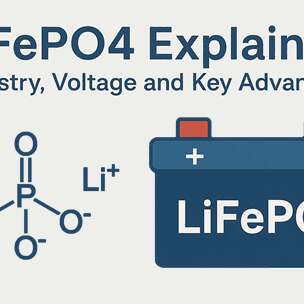LiFePO4 for Solar & Off-Grid Systems: Sizing, Wiring, Charge Controllers and Best Practices
LiFePO4 batteries are fast becoming the default for solar and off grid installs because they pack high cycle life, flat discharge curves and lighter weight compared to lead- acid. Below is a practical, no- fluff guide to get you sizing, wiring and configuring a system that actually lives up to LiFePO4’s promises.
Sizing the bank
Think in amp/hours and usable capacity, not just nameplate Ah. For a 12V LiFePO4 100Ah pack you get roughly 100Ah x 12V = 1.2 kWh nominal; many owners plan usable depth to 80-90% for long life and size accordingly. For longer autonomy, scale by volts: 24V and 48V banks reduce current for the same power, which cuts cable size and losses. Aim to match PV array and inverter specs to the battery bank voltage early in design.
Charge controllers and settings
Use an MPPT charger configured for LiFePO4: set bulk/absorption to about 3.55-3.65V per cell (so roughly 14.2-14.6V for 12V, 28.4-29.2V for 24V, 56.8-58.4V for 48V). Float is usually lower or not needed; many systems use ~13.6V float if the controller requires one. Consult your battery maker and your MPPT manual.
Wiring, fuses and safety
Higher bank voltage means lower currents and smaller, cheaper copper runs. Still, keep runs short between battery and inverter: choose AWG sized to the maximum continuous current and protect with a fuse or breaker sized to safeguard the cable. Use published inverter to battery tables as a baseline and upsize for longer runs to limit voltage drop. Properly rated fuse, correct polarity and solid lugs will save you trouble down the road.
BMS and parallel banks
Never skip a BMS: it protects against over/under voltage, overcurrent and assists balancing. If you parallel multiple LiFePO4 modules, ensure each module has its own BMS or use an expertly designed master BMS strategy and top balance before paralleling if needed. Active balancing speeds equalization, passive BMS balancers work too; follow manufacturer guidance.
Best practices
- Wire for the highest practical nominal voltage to reduce current.
- Configure MPPT absorption short and avoid constant high voltage float.
- Keep BMS telemetry and temperature sensors in place; mounting temp matters.
- Match cell chemistry and age when paralleling, and keep cable lengths equal for each parallel leg.
LiFePO4 rewards good design with years of high cycle service; size sensibly, wire stoutly and configure your charge controller for LiFePO4 chemistry and you’ll have a reliable off grid heart that hums rather than hassles. #LiFePO4 #SolarStorage #OffGridSystems

